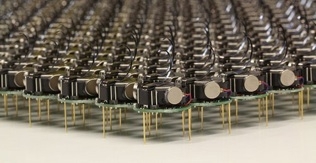New technology for controlling hundreds of tiny robots could pave the way for autonomous swarms that search for survivors in collapsed buildings.
Swiss firm K-Team Corporation has begun producing the 3cm-dimaeter ’Kilobots’, developed and licensed by researchers at Harvard University in the US, which can be programmed to operate in large numbers as an independent collective.
The researchers says robot swarms might one day tunnel through rubble to find survivors, monitor the environment and remove contaminants, or self-assemble to form support structures in collapsed buildings. They could also be deployed to autonomously perform construction in dangerous environments or assist with pollination of crops, inspired by insects such as ants or bees that work together in large numbers.

’The Kilobot will provide researchers with an important new tool for understanding how to design and build large, distributed, functional systems,’ said Michael Mitzenmacher of the Harvard School of Engineering and Applied Sciences. ’Plus tiny robots are really cool!’
The ominous-sounding name ’Kilobot’ actually refers to the researchers’ goal of quickly and inexpensively creating a collective of a thousand bots.
The bug-like devices scuttle around on three toothpick-like legs, interacting and coordinating their own behaviour as a team without the need for human intervention. Issues of time, cost and complexity have previously prevented researchers from testing control algorithms in the real world on more than a few dozen robots at a time.
The Kilobots, created by members of Harvard’s Self-Organizing Systems Research Group led by Radhika Nagpal, are a low-cost solution that allows a single user to easily oversee the operation of much large numbers of robots.
They are designed to provide scientists with a physical testbed for advancing the understanding of collective robot behaviour. Tests so far have focused on programming the devices to operate in formation, synchronise their functions and simulate the process of foraging for food.




Project to investigate hybrid approach to titanium manufacturing
What is this a hybrid of? Superplastic forming tends to be performed slowly as otherwise the behaviour is the hot creep that typifies hot...